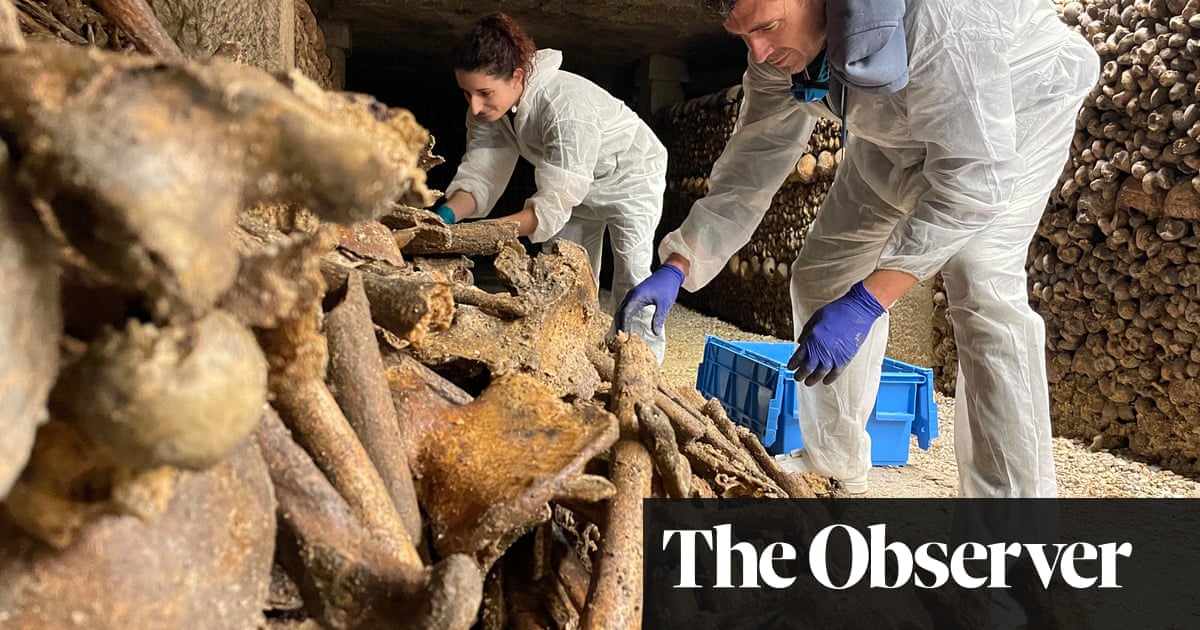Deep beneath the streets of Paris, the dead are having their last word. They are recounting 1,000 years of death in the city: how many are buried in the labyrinth of tunnels that make up Les Catacombes, what killed them and how the diseases that may have led to their demise have developed over the centuries.
In the first ever scientific study of the site, a team of archeologists, anthropologists, biologists and doctors is examining some of the skeletons of an estimated 5-6 million people whose bones were literally dumped down quarry shafts at the end of the 18th century and beginning of the 19th.
“Astonishing as it may seem, there has never been any serious scientific study of the catacombs,” said Philippe Charlier, who is leading the project. “Our research is looking at 1,000 years of the history of public health in Paris and its suburbs, of the medicine and surgery people underwent and the illnesses they suffered.
“There are other ossuaries in the world, but this is probably the biggest so it’s unique. It’s the ideal place to carry out an anthropological and paleoanthropological study.”
A sign at the entrance to Les Catacombes, a 300km (186 mile) network of tunnels 20 metres underground warns the 550,000 annual visitors to the site in capital letters: “Stop! This is the Empire of Death.”
In the latter half of the 18th century, the city authorities decided to exhume bodies interred at Les Innocents near what is now Les Halles, in central Paris, and from other overcrowded city cemeteries, ostensibly for health reasons.
“The story goes people would be drinking, eating or dancing in a cellar tavern or cabaret when a wall would collapse and decomposing bodies fall in on them. Just imagine the scene,” Charlier said. “It was then the authorities realised it was no longer possible for Paris cemeteries to absorb the number of dead being buried. They decided the miasma was dangerous for public health so a commission was set up to decide what to do with the bodies.
“The official justification was public health, but I suspect that with demographic pressure in Paris there was a real financial and economic interest in recovering the land for property.”
In 1788, under cover of night, an operation began to remove millions of buried bodies. They were dug up and loaded on to ox carts that rumbled across the city accompanied by a priest to what were then the suburbs.
“They were just dropped down the disused quarry shafts that had served to bring up the stone used to build Paris and left piled up where they fell,” Charlier said.
In 1810, the inspector general of quarries, nobleman Louis-Étienne Héricard de Thury, decided some respect should be shown for the dead and arranged skulls and long bones – femur, tibia, humerus – into decorative walls, known as hagues.
“He transformed it into a place that could be visited, not just for tourists but as a kind of philosophical cabinet with engraved inscriptions,” Charlier said.
But behind the meticulously arranged facades, built like dry-stone walls, the remaining bones lay in a rubble-like mess.
Today, in another section of the labyrinth of tunnels, masons engaged by the Catacombes de Paris, which runs the heritage site, are repairing a section of hague that has collapsed due to water seepage.
“It’s the same savoir faire [know-how] used in building a dry wall,” said Florent Bastaroli as he placed smaller bones in between meticulously neat rows of larger bones and skulls.
after newsletter promotion
“It does make you think about our own mortality and how we all end up like this.”
After one of the hagues collapsed in 2022, Charlier’s team from the University of Versailles and Saint-Quentin-en-Yvelines was given the opportunity to study the site.
As well as looking at the amputations, trepanations, autopsies and embalmings that the dead underwent, the study includes what scientists call palaeopathology to determine what diseases and parasitic infections they suffered as well as poisonings by heavy metals, including lead, mercury, arsenic and antimony.
Charlier says maladies that leave a trace on human bones, including rickets, syphilis and leprosy, are easier to identify, but DNA extraction from teeth allows them to pinpoint infectious agents such as the plague that kill too rapidly to make a mark.
“We can also see, for example, if the syphilis that killed someone in the 16th century is the same as the syphilis of today or whether the infectious agent of the disease has micro-evolved,” he added.
So far, Charlier’s team has been scanning bones and taking samples. He says radiocarbon dating, which they have yet to carry out, will enable them to establish the age of the bones, and simple counting should give a more accurate estimate of the number of bodies in the catacombs. He expects the figure to exceed 6 million.
The project is now in its third year and the team will produce the first preliminary findings before the end of the year. Charlier predicts the work will outlive his career.
“The task is enormous. It is work without an end. I think the student children of my students will continue this and that is good,” he said.
The aristocratic Count de Thury preferred not to look too far into the future. As one of the inscriptions he placed in the catacombs reminds visitors: “Think in the morning that you may not make it to the evening and in the evening that you may not make it to the morning.”

